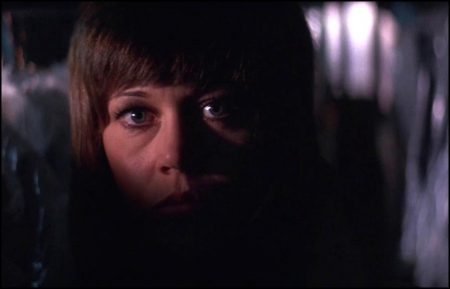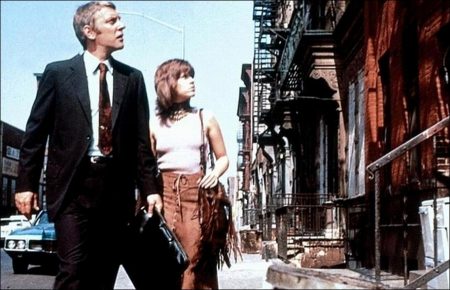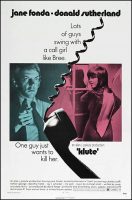Taglines: You’d never take her for a call girl. You’d never take him for a cop.
Klute movie storyline. Tom Gruneman suddenly disappears in New York without leaving any clues behind. After a while, his wife Holly and his boss Peter are forced to hire a private investigator. They knock on the door of a detective named John Klute, an old friend of Tom’s. John Klute accepts the case, starting with a letter to a prostitute named Bree, the only thing left of Tom. Klute constantly intends to put Bree on the phone, listening to his phone calls, and getting her involved. The events can only be solved by his help. This process turns into an adventure where unexpected things happen.
Klute is a 1971 American neo-noir crime thriller film directed and produced by Alan J. Pakula, written by Andy and Dave Lewis, and starring Jane Fonda, Donald Sutherland, Charles Cioffi, and Roy Scheider. It tells the story of a high-priced prostitute who assists a detective in solving a missing person case.
Klute is the first installment of what informally came to be known as Pakula’s “paranoia trilogy”. The other two films are The Parallax View (1974) and All the President’s Men (1976). The music was composed by Michael Small.
Upon its release, the film received widespread critical acclaim for its direction, screenplay, and performances – in particular that of Jane Fonda. Fonda won an Academy Award for Best Actress, and the film was also nominated for Best Original Screenplay. Klute was a commercial success, grossing $12 million against a $2.5 million budget.

Film Review for Klute
“Klute” is a film-noir that triggers the fear of sound recording of the Watergate Scandal during the US paranoia in the 70s. But it is essentially the first work that uses the key features of political-tension. So much so that its director Alan J. Pakula breaks new ground by adopting the cool style of directing. In this way, it gives clues to the later part of his career. The leading roles are Jane Fonda and Donald Sutherland.
John Klute (Donald Sutherland) is an ordinary detective working in towns. However, his friend Tom Gruneman, who is an engineer, suddenly decides to take a turn. Klute begins watching Gruneman’s only source, the call-girl Bree Daniels (Jane Fonda). When Daniels discovers that Klute has placed a pager in her phone, a dangerous relationship will begin. So much so that Bree leads Klute into a passionate love on the one hand and is followed by a man he doesn’t know.
One of the most important sources of inspiration of the political-tension genre born in the 1970s, the work bears the signature of a groundbreaking name such as Alan J. Pakula with his serene, voyeuristic and minimalist direction. ”Klute” (1971), the first link of the director’s paranoia trilogy, is a clever film that actually puts the problem of the düşman enemy within us born with the Watergate Scandal, Cold War and Vietnam War. The fact that he transferred the film to cinema with political-tension patterns also increases its importance.
This special film can be summarized as follows:
1- Source taken from film-noir
Criminal films were known to be dominant in the early 1930s with gangster films, and from 1942 on film noir Hollywood. This area, which ended with Orson Welles’ of Touch of Evil ’in 1956, was in fact looking for a new and revolutionary representative. At this time, in the 60s, different tendencies began to appear in this quest. So much so that Arthur Penn’s “Bonnie and Clyde”, 1967) was a lov lovers-on-the-run road movie,, “Point-Blank” (1967), the neo-noir (color film noir).
Alan J. Pakula’s “Klute”, on the other hand, emphasized the film grammar and thematic integrity of the political-thriller that would make a breakthrough in the 70s with the elements of film noir. Thus, the political tension that will rise to the top has gained momentum with Hitchcock’s North by Northwest (1959), or the thematic totality behind “The Machurian Candidate (1962). he was acquiring grammar. So much so that these two films are referred to as the heirs of political-tension in many sources…
“Klute” can in fact be referred to as a film noir, even post-noir, with the use of angle, shadow plays, serenity and system criticism. Philip Marlowe even though the ordinary detective John Klute added to this situation. Reveals what the film did to the genre. However, it should be called ‘one of the works that intertwine certain genres with film noir. So much so that what Pakula wants to do here is to create a ‘political-tension-noir thr (thriller-noir). In this way, the voyeuristic man constantly disguises his / her identity, and we are inevitably lost to the feeling that the main character is the system that watches from above.
Thus, the director uncovers the dirty laundry of the system in a mysterious and opposing way. The minimalist close film grammar here contributes to the tension and disturbs the standard audience, which heralds the fundamental rise of the cinematic language of the political-tensions of the 70s. Of course, the fact that the use of sound and music is ‘sharp ted is disturbing.
2- The first leg of the paranoia trilogy
Already the main purpose of the director’s Cold War, Vietnam War and Watergate Scandal after the “inside threat” to reveal the situation. In fact, this is achieved through the free spirit of New Hollywood. Because he wanted to create a series of films called ‘paranoia trilogy al, he took this light. The most important sum of Alan J. Pakula’s career is this trilogy.
All three of these films, which provide a summary of the director’s career, are all harsh works that draw attention with their political discourse and American management concerns. The dramatic structures are actually quite striking walks. However, when we look at the basics, the first one, “Klute”, is a dark film tone. In fact, while transforming the individual of the call-girl organization into femme fatale (also known as the vamp), it is a work that builds its dramatic structure on loneliness, hypocrisy and stuckness alongside the persecution of innocent people by the leaders. We have before us.
Following the birth of the film’s grammar of political tension, 1974 The Parallax View (1974) coincides with the sheer political-tension that Pakula wants to prepare for. That work deals with the escape of an innocent man, a second-class journalist, from the system. For this, he traces a company called ‘Parallax Company hip that hypnotizes innocent people and turns them into murderers. 1976 All The President’s Men Men of 1976 dates back to the true story of two journalists studying the Watergate Scandal.
This work, all of which is based on Pakula’s plan sequences or uninterrupted plans, is actually the most politically remarkable film director. However, film noir is of great importance in terms of completing the political-tension and political-drama trilogy.
3- Are our voices being recorded?
In fact, the main problem of the film is üzerinden recording the sounds sonrası after the Watergate Scandal. So much so that what interferes with privacy or private life is an important issue here. Later on, this aspect has already made an impact on many films, “Prostitute”. Here, with the disappearance of an ordinary but rich man, voice recordings with prostitute Bree Daniels emerge.
This continues when detective Klute steps in and records the sound of Daniels’ apartment. On top of that we understand that there is also a voyeur. In other words, there is an intimacy or non-intimacy which is disengaged with both the voice and the eye. In fact, Hitchcock has dealt with this in detail in özellikle Rear Window 195 (1954). But the issue had never gone to such a political point before.
So much so that at a point you do not expect records appear and your life may be upset. This is already the most concrete material of fear, both from the system, from leaders, from outside or from inside. The film makes the issue of sound and the inner voice of the whore character a lot on the actual image, making it scary and tense.
In other words, the real situation that disturbs this privacy is the presence of that character. Already in this tension is not scary psycho who killed two prostitutes scary sound recordings and voyeur put in our place. In a sense, the patterns of film noir are reversed and the system is replaced by the killer.
4- Two effects as a directing miracle
In a film in which the killer was such a nothingness, I suppose something different could not be expected. In fact, while Pakula places the whole work on a serene texture of noncommunication and deals with what lies beneath New York City, he does not neglect to put that perfect or shocking point in his last scene. Obviously, this hypocrisy emerges when this part occurs from a clothing store. Because we watch Bree’s dress and makeup that changed her throughout the film.
But the main thing is the one or two frame jumping effect that the director only uses twice to reveal the killer. In the first, he shifts the camera between the clothes, and in the second he activates it with the killer’s middle plan. Why he did it is a matter of deep discussion … It can be diversified with various interpretations.
But this situation, which strengthens the film’s visually revolutionary network, is actually used to criticize mathematical systematization. For this reason, it can be said that it is in place. The first one deteriorates the shift perception, and the second the eyelid moves faster than necessary for a few seconds. Thus, a visual critique of the systematic is made from bottom to bottom.
The system is so mathematical that you will understand that even human movement is restricted! This is a metaphor or detail that reveals how bold and revolutionary Pakula’s modern cinema actually is.
Klute (1971)
Directed by: Alan J. Pakula
Starring: Jane Fonda, Donald Sutherland, Charles Cioffi, Roy Scheider, Dorothy Tristan, Rita Gam, Nathan George, Vivian Nathan, Morris Strassberg, Shirley Stoler, Jane White, Anthony Holland
Screenplay by: Andy Lewis, David E. Lewis
Cinematography by: Gordon Willis
Film Editing by: Carl Lerner
Costume Design by: Ann Roth
Set Decoration by: John Mortensen
Art Direction by: George Jenkins
Music by: Michael Small
Distributed by: Warner Bros. Pictures
Release Date: June 23, 1971
Views: 263

